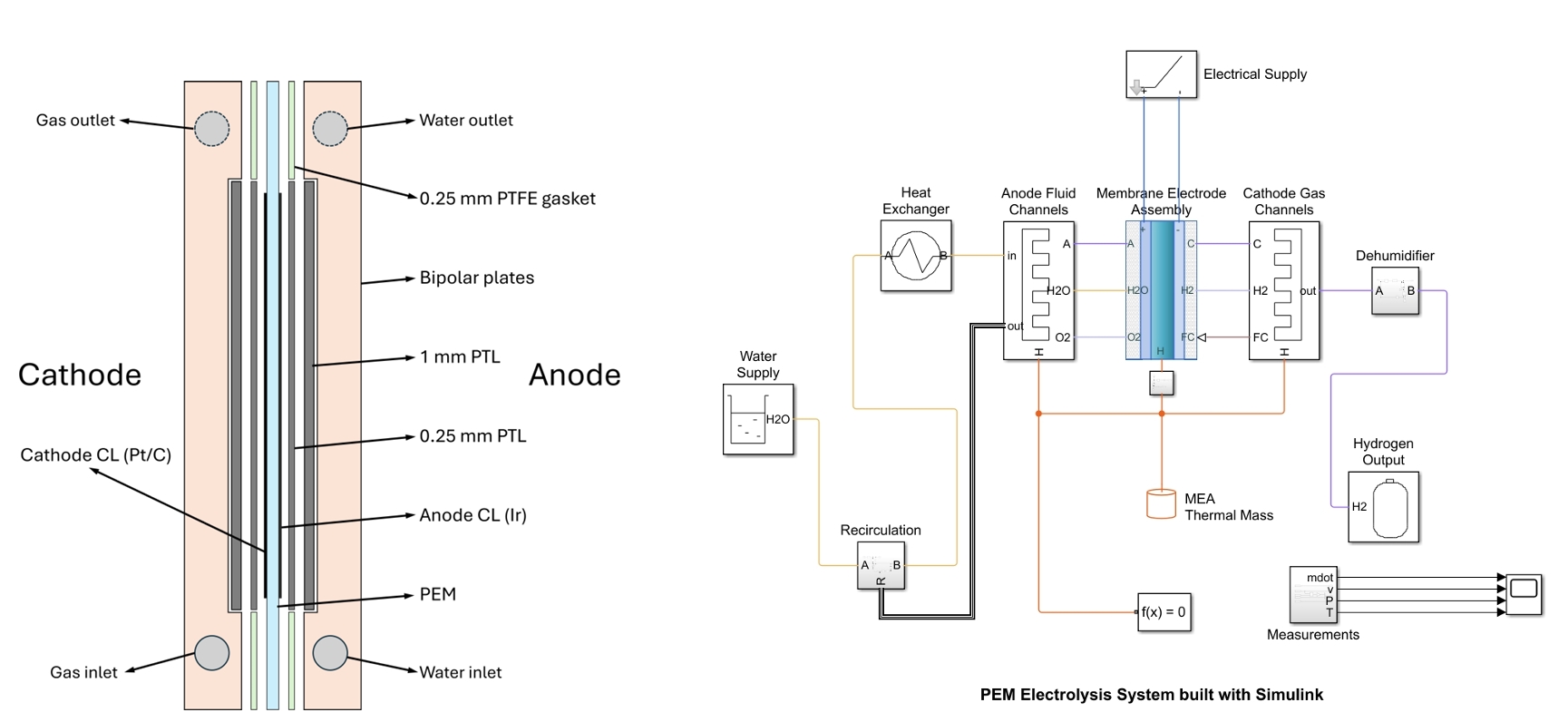Optimization of the UK Multi-Electrochemical Energy Storage for Resilience and Uncertainty Management in a Low-Carbon Context
Abstract and Vision
This research investigates the design, optimization, and uncertainty analysis of a Multi-Electrochemical Energy Storage (MES) system to meet diverse energy demands across European climate zones, focusing on the UK1. By characterizing uncertainty and conducting sensitivity analysis, the study aims to establish a robust framework for selecting, sizing, and planning electrochemical storage technologies. Key goals include enhancing MES responsiveness to demand fluctuations, reducing environmental impact, and supporting sustainability. Using Monte Carlo simulations and global sensitivity analysis, this research will identify critical parameters affecting MES performance, optimizing configurations to align with low-carbon objectives.
The envisioned MES framework provides guidelines for efficient, resilient, low-carbon energy solutions tailored to the UK’s climate and energy needs, aligning with the UK’s Net Zero Government Initiative roadmap for achieving net-zero emissions.
 Proposed Framework for this Three Months’ Study
Proposed Framework for this Three Months’ Study
1. Aim and Objectives
Aim
To optimize the design and operation of a Multi-Electrochemical Energy Storage (MES) system in Europe, using the UK climate zone as a representative case2. This includes selecting appropriate technologies, determining optimal sizing, and evaluating full-year operational performance. The study incorporates uncertainty and sensitivity analyses to enhance system responsiveness to energy storage needs and minimize environmental impact.
Objectives
The objectives of this research are to develop an optimized design framework for Multi-electrochemical energy storage (MES) systems. This framework will leverage mixed-integer linear programming (MILP) to model and optimize MES configurations, balancing energy supply and storage while minimizing both total system costs and CO₂ emissions3.
Key focuses include:
- Integrating electrochemical energy storage solutions such as electrolysis or battery storage to enhance the resilience of MES to fluctuating renewable energy availability and varying energy prices.
- Conducting sensitivity analysis on critical design features (e.g., storage size, renewable capacity) to identify their impact on cost, environmental benefits, and overall system performance under different climatic conditions.
- Providing practical implementation guidelines for MES that support low-carbon energy goals, reduce costs, and ensure reliable long-term operation.
These insights will aid policymakers and industry stakeholders in adopting sustainable MES configurations tailored to diverse regional needs.
 Optimization Framework for Multi-electrochemical Energy Storage Systems
Optimization Framework for Multi-electrochemical Energy Storage Systems
2. Methodology
UK Data Integration and Framework Development
- Data Collection and Modeling: Gather UK-specific data, including climate conditions, renewable energy potentials (especially wind and solar), seasonal demand profiles, and region-specific energy costs. Collect data on electrochemical storage parameters, relevant UK government incentives, and carbon reduction policies4.
- Framework Development: Use Mixed-Integer Linear Programming (MILP) to build a foundational MES model that reflects the UK’s energy infrastructure.
Optimization and Uncertainty Analysis under UK Conditions
- MILP-Based Optimization: Formulate an optimization problem focused on minimizing costs and CO₂ emissions, incorporating UK-specific constraints such as grid standards, renewable capacity limits, and operational restrictions.
- Uncertainty and Sensitivity Analysis: Address key uncertainties such as energy prices, wind/solar variability, and electrochemical storage costs. Use Monte Carlo simulations to assess the impact of these uncertainties on MES performance.
Validation, Scenario Testing, and Policy Recommendations for the UK
- Model Validation and Scenario Testing: Validate the model using UK energy system data and test scenarios with different renewable penetration levels, demand fluctuations, and policy landscapes.
- Guideline Development and Dissemination: Provide UK-focused recommendations for optimal MES configurations and storage solutions. Develop guidelines for policymakers and industry stakeholders that support low-carbon targets and cost-effectiveness5.
3. Historical Work Introduction
S2: Dynamical Modeling and Simulation of PEM Water Electrolyzers Systems
In work package S2, a KW-level PEM water electrolyzers system was examined, focusing on modeling core components of the PEM electrolyzer, including the membrane electrode assembly (MEA) and supporting systems like water circulation and thermal management. A simulation framework was developed using MATLAB’s Simscape™ to capture the electrochemical interactions within the MEA6.
 PEM Water Electrolyzer System Configuration and Schematic Diagram
PEM Water Electrolyzer System Configuration and Schematic Diagram
S3: Data-driven Prediction of PEM Water Electrolyzers Components
In work package S3, the performance of the Membrane Electrode Assembly (MEA) in Proton Exchange Membrane Water Electrolysis (PEMWE) systems was optimized using data augmentation and machine learning. By compiling a dataset and leveraging Generative Adversarial Networks (GANs) and random forest algorithms, a predictive modeling framework was developed to forecast MEA performance across various operational scenarios7.
 Proton Exchange Membrane Water Electrolysis Component Performance Prediction using Data Augmentation and Deep Learning
Proton Exchange Membrane Water Electrolysis Component Performance Prediction using Data Augmentation and Deep Learning
Consistency and Synergy Across Work Packages
Work packages S1, S2, and S3 are interlinked, each contributing to the comprehensive optimization framework for MES systems. S2 provides a broad evaluation framework, while S3 enriches the system model by contributing data on hydrogen production efficiency and stability, enhancing electrochemical storage reliability in the MES framework.
4. Proposed Outcome
- Cost Savings and Emission Reduction: The optimized MES design framework will enable significant cost reductions and emissions savings by integrating electrochemical storage and optimizing energy flows.
- Data-Driven Decision-Making: Sensitivity analysis and uncertainty modeling will identify key factors impacting MES stability and cost, providing strategies for resilience and financial viability under fluctuating conditions.
- Region-Specific Policy and Industry Guidelines: Practical guidelines will equip policymakers and energy providers with pathways for implementing MES systems that align with regional carbon and cost objectives.
5. Resource Requirement
Time Resource Allocation (Three-Month Project)
- Data Collection Phase: Weeks 1-3
- Model Development Phase: Weeks 4-7
- Optimization Phase: Weeks 8-10
- Validation and Testing Phase: Weeks 11-12
- Documentation and Reporting Phase: Final Delivery
Detailed Overview of Funding and Time Allocation for Ph.D. Student’s Project
| Role | Name | Start Date | Time Duration |
|---|---|---|---|
| Ph.D. Researcher | Haotian MA | 01/04/2025 | 12 weeks |
Project Expenses and Monthly Costs (£)
| Item | Cost (£) | Item | Cost (£) |
|---|---|---|---|
| Superannuation and NI | 300 | Computing Resources | 2,500 |
| Software Licenses | 500 | Experimental Materials | 700 |
| Conference and Travel Allowance | 1,000 | Basic Monthly Salary Expenses | 1,500 |
| Equipment Maintenance | 400 | Data Acquisition and Processing | 400 |
| Publication Fees | 200 |
Total Funding Required Over Project Duration: £12,800
References
Alina Averchenkova, Sam Fankhauser, and Jared J Finnegan. “The impact of strategic climate legislation: evidence from expert interviews on the UK Climate Change Act”. Climate Policy 21.2 (2021): 251–263. ↩
Mohamed Farghali et al. “Social, environmental, and economic consequences of integrating renewable energies in the electricity sector: a review”. Environmental Chemistry Letters 21.3 (2023): 1381–1418. ↩
John Barrett et al. “Energy demand reduction options for meeting national zero-emission targets in the United Kingdom”. Nature Energy 7.8 (2022): 726–735. ↩
Lintong Liu et al. “Comprehensive sustainability assessment and multi-objective optimization of a novel renewable energy driven multi-energy supply system”. Applied Thermal Engineering 236 (2024): 121461. ↩
Charles Newbold, Mohammad Akrami, and Mahdieh Dibaj. “Scenarios, Financial Viability and Pathways of Localized Hybrid Energy Generation Systems around the United Kingdom”. Energies 14.18 (2021): 5602. ↩
Hasim Sak, Andrew W Senior, and Françoise Beaufays. “Long short-term memory recurrent neural network architectures for large scale acoustic modeling”. (2014). ↩
Laetitia Uwineza, Hyun-Goo Kim, and Chang Ki Kim. “Feasibility study of integrating the renewable energy system in Popova Island using the Monte Carlo model and HOMER”. Energy Strategy Reviews 33 (2021): 100607. ↩
